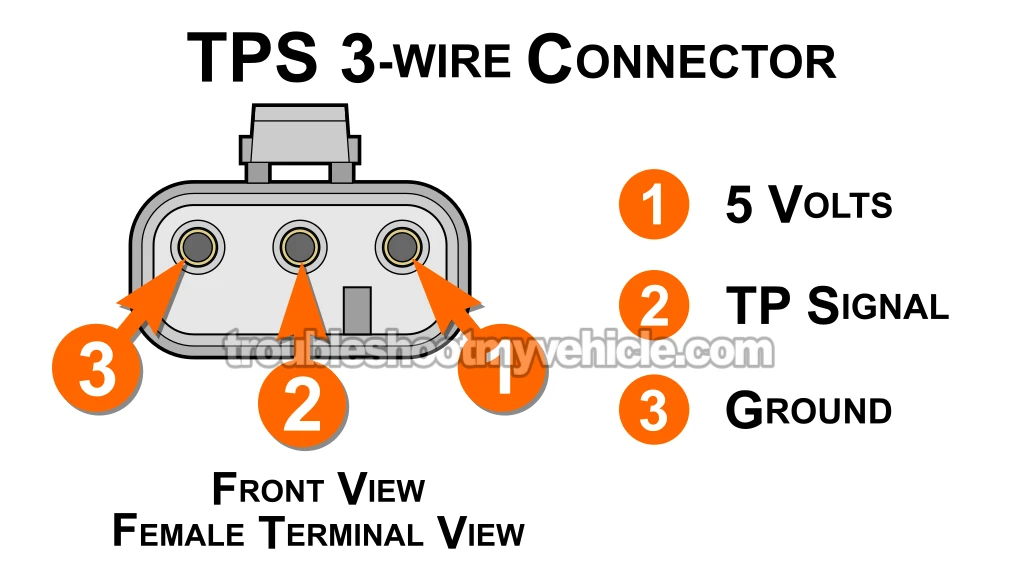TEST 2: Making Sure The TPS Is Receiving 5 Volts

If your TPS voltage stayed stuck during TEST 1, there's a strong chance it's because the sensor isn't getting power.
In this next test, we're gonna check if the violet with white stripe (VIO/WHT) wire at the TPS connector is supplying between 4.5 and 5 Volts DC.
This VIO/WHT wire hooks into the female terminal I've marked as number 1 on the sensor's 3-wire connector (check the connector diagram above).
To confirm that this wire is delivering the proper voltage (to the TPS), we'll use a multimeter to test the voltage right at the terminal on the connector.
Here's how to run this test:
- 1
Set your multimeter to read Volts DC.
- 2
Attach the black test lead to the battery's negative (-) post.
- 3
Turn the ignition key to the ON position, but don't crank the engine.
- 4
Unplug the TPS from its electrical connector.
- 5
Use the red test lead to carefully check terminal 1 on the TPS connector.
Make sure the VIO/WHT wire is connected to terminal number 1.
NOTE: Be careful when probing it so you don't damage the terminal inside the connector. - 6
Your multimeter should show a voltage between 4.5 and 5 Volts DC.
Now, let's look at what your results tell us:
CASE 1: You're getting 4.5 to 5 Volts. Perfect —this means the TPS is receiving power, just like it should.
Next up, we'll test for Ground. Go to: TEST 3: Making Sure The TPS Is Receiving Ground.
CASE 2: No 4.5 to 5 Volts detected. If there's no power getting to the sensor, it won't be able to send out its voltage signal.
The most common reasons for this missing voltage are:
- A break or open-circuit somewhere between the TPS connector and the fuel injection computer.
- Less commonly, a fault inside the computer itself could be the problem.
Even though tracking down the source of this missing voltage is beyond what this guide covers, now you know the TPS isn't the issue. The next step is to dig into why those 5 Volts aren't reaching the sensor.
TEST 3: Making Sure The TPS Is Receiving Ground

Here's where we're at with your TPS tests so far:
- TEST 1: The voltage signal from the TPS doesn't rise or fall when the throttle plate moves.
- TEST 2: Power is reaching the TPS.
Now, in this final test, we're gonna make sure the black with light blue stripe (BLK/LT BLU) wire is supplying a solid Ground to the TPS.
The wire we're looking at connects to terminal 3 of the TPS connector —take a look at the diagram above if you need to double-check its position.
This BLK/LT BLU wire is the one responsible for feeding Ground to the sensor, and we're gonna confirm that with a simple voltage test using a multimeter.
NOTE: The Ground provided directly by the fuel injection computer. Never apply 12 Volts from the battery directly to this wire —you'll damage the computer. The multimeter method outlined here is safe and won't harm the circuit nor the computer.
Here's how to check for Ground at the TPS connector:
- 1
Set your multimeter to Volts DC mode.
- 2
Place the red test lead on the battery's positive (+) terminal.
- 3
Turn the ignition key to the ON position —don't start the engine.
- 4
Unplug the TPS from its connector.
- 5
Use the black test lead to gently probe terminal 3 of the TPS connector.
Make sure the BLK/LT BLU wire is plugged into terminal number 3.
NOTE: Be extra careful not to bend or damage the terminal inside the connector. - 6
If the Ground is good, your multimeter should read between 10 and 12 Volts DC.
Let's go over what your reading means:
CASE 1: You've got Ground (10 to 12 Volts showing on the meter). That's the result we want to see.
If you've confirmed all of the following, it's safe to say the TPS is bad and needs to be replaced:
- The TPS voltage didn't change when you moved the throttle plate (TEST 1).
- The TPS is getting 4.5 to 5 Volts of power (TEST 2).
- The TPS is getting a solid Ground (this test).
CASE 2: No Ground detected. Double-check your test setup —make sure you're probing the right terminal and have solid connections.
If your multimeter still doesn't show 10 to 12 Volts, then the TPS itself is fine. The issue is that it's not receiving Ground, which is why it's not sending out a changing signal.
Even though digging into the missing Ground is beyond this guide, you now know the sensor isn't the problem. The next step is to find out why the Ground isn't getting to it.
Here are the most common reasons:
- A break or open-circuit in the wire between the TPS connector and the fuel injection computer.
- In rare situations, the computer itself has a fault internally.
More 3.9L V6 Dodge Ram Pickup Tutorials
You can find a complete list of 3.9L V6 Dodge Ram pickup tutorials in this index:
Here's a small sample of the tutorials you'll find in the index:
- How To Test For A Blown Head Gasket (1989-2001 3.9L V6 Dodge Ram Pickup).
- How To Test The Fuel Pump (1989-1991 3.9L V6 Dodge Ram Pickup).
- How To Test The Distributor Pickup Coil (1989-1991 3.9L V6 Dodge Ram Pickup).
- Throttle Body Temp Sensor Tests (1989-1991 3.9L V6 Dodge Ram Pickup).

If this info saved the day, buy me a beer!

